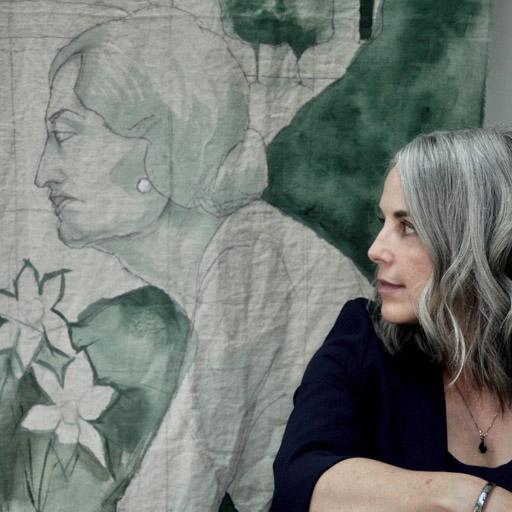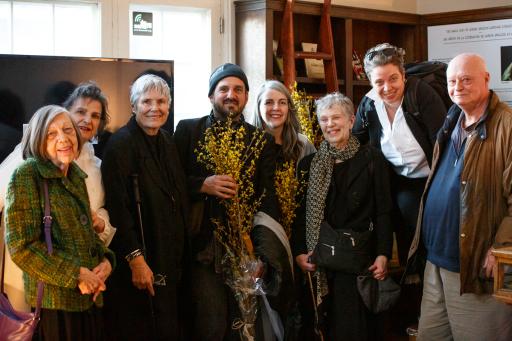
Dr Hammond in her studio, 2023. Photo: Jason Levy.
Dr Cynthia Imogen Hammond, PhD
Pronouns: she/her
- Professor, Art History
status: On medical leave
Are you the profile owner?
Sign in to editContact information
Email:
Availability:
Websites:
Biography
Biography
Dr Cynthia Hammond was born in 1969 in Hamilton, Ontario, on the traditional lands of the Haudenosaunee and the Anishinabewaki nations. She studied painting, sculpture, and art history at McMaster University in Hamilton (BFA 1992), and art history at Concordia (MA 1996). Her doctorate from Concordia's Interdisciplinary PhD Program (2002) won the Governor-General's Gold Medal. Hammond held the first SSHRC postdoctoral fellowship at the School of Architecture, McGill University (2004-06). She joined Concordia's Department of Art History in 2006.
Hammond's publications explore a range of topics within or adjacent to the history of architecture, including the history of gardens, installation art, photography, built heritage, public memory, oral history, and Canadian women artists. Hammond's paintings focus on interspecies relationships between women and non-human beings in gardens and other kinds of living landscapes. In 2023 Hammond was artist-in-residence at La Napoule Art Foundation in France, where she subsequently participated in the group exhibition, "Résonance", in 2024.
Distinctions & Awards
2018-19 Concordia University Research Award, Category B, The Person and Society
2017 Faculty of Fine Arts Distinguished Teaching Award - Established FT Faculty Member
2015 Concordia Council on Student Life - Outstanding Contribution Award
2006-07 Nineteenth Century Studies Association, Emerging Scholar Award
2002 Governor General’s Gold Medal for Doctoral Dissertation

Dr Hammond speaking about her art practice at La Napoule Art Foundation, France, April 2023
Raneece Buddan, 2023

The 2018 University Research Award Ceremony
© Concordia University

Collaborators in the Promenade Parlante public art walk, 13 April 2019. Left to right: Lillian Harper, Penelope Cumas, Wanda Potrykus, Eric Craven, Cynthia Hammond, Wendy Allen, Shauna Janssen, Ramsay Blair. Not pictured: Doug Dumas.
Lisa Graves, 2019
Theorizing research-creation and place-based, site-responsive art
Hammond's book, Architects, Angels, Activists and the City of Bath, 1765-1965: Engaging with Women's Spatial Interventions in Buildings and Landscape (Ashgate 2012) explores cultural memory and public history in the world-renowned city of Bath, England, one of the few UNESCO World Heritage-designated cities. Hammond approaches the past with the methods of the architectural historian and the site-specific interventions of the contemporary artist. Looking beyond and behind Bath's strategic marshaling of its past, and its reiteration of male architectural heroes, Hammond presents the ways in which women of all classes shaped the built environment and designed landscapes of one of England's most architecturally significant cities. This book is also, as research-creation, an intervention into this city's urban, public memory. The author uses site-specific works of public art as strategic counterparts to her historical readings. Through them, she aims to transform as well as critique the urban image of Bath. At once a performative literature, an extensively researched history, and an alternative guide to the city, Architects, Angels, Activists engages with struggles over urban signification in Bath and beyond.
Teaching activities
Recent undergraduate courses:
ARTH 374 Montreal's Vernacular Architecture
ARTH 355 Spaces of Restorative and Transitional Justice
ARTH 450 Advanced Seminar in the History of Architecture: space, experience, architecture
ARTH 668 Feminisms, Oral History, and Art History
ARTH 803 Thematic Questions: Spatial Practices, Spatial Stories
Recent thesis supervision:
Olivia Vidmar, MA, Art History (2023), "Possibilities of Public Art as an Agent of Renewal and Resistance in Pointe-Saint-Charles"
Elizabeth Robinson, MA Art History (2023), "Reframing the Occult-inspired Paintings of Leonora Carrington and Remedios Varo with Anti- Essentialist Methodology"
Vanessa Sicotte, MA, Art History (2022), "Resistant Materiality in Interwar France: Charlotte Perriand's Table basse manifeste pour Jean-Richard Bloch (1937), and Other Manifestos"
Lisa Massa, MA, Art History (2022), "Navigating Bella Figura: Inside the Childhood Homes of Six Second-Generation Italian- Canadian Women in Montreal"
Recent publications
For the full list of Dr Hammond's publications, please see her CV.
2023. "Unearthing Feminine Legacies: Cynthia Hammond’s immersive exploration of historic and hidden gardens" (interview). Art Seen: The Curator’s Salon Magazine, Ed. Gita Joshi, 9 (Fall 2023): 31-37.
2022. “A Feminist Arcadian Landscape: The Later Work of Joyce Wieland.” For a special issue of The Journal of Canadian Art History on Joyce Wieland. Ed. Johanne Sloan and Mark Clintberg. 70-99.
2021. “Architecture, Photography, and Power: Picturing Montreal, 1973-74.” In Photogenic Montreal: Ruins and Revisions in a Postindustrial City. Ed. Johanne Sloan and Martha Langford. Montreal, Kingston: McGill-Queen’s University Press. 217-245.
2021. “Glacier, Plaza, and Garden: Ecological collaboration and didacticism in three Canadian landscapes.” Sustainability. Special issue: “Eco-Didactic Art, Design, and Architecture in the Public Realm.” Ed. Carmela Cucuzzella, Jean-Pierre Chupin, and Cynthia Hammond. Vol. 13 (May 2021): 1-19.
2019. “‘The Gardens will be Illuminated’: Gendered and Georgian Pleasures in Sydney Gardens, Bath.” Bath History XV (September 2019): 9-33.
2019. Les Jardins des femmes (exhibition catalogue). Gallery of the School of Architecture, McGill University, 15-25 June. With an introduction and text by Annmarie Adams. Montreal: Gail and Stephen A. Jarislowsky Institute for Studies in Canadian Art, 2019.
Art and collaborations
For an up-to-date list of Dr Hammond's art and creative collaborations, please visit her online portfolio at http://cynthiahammond.org


